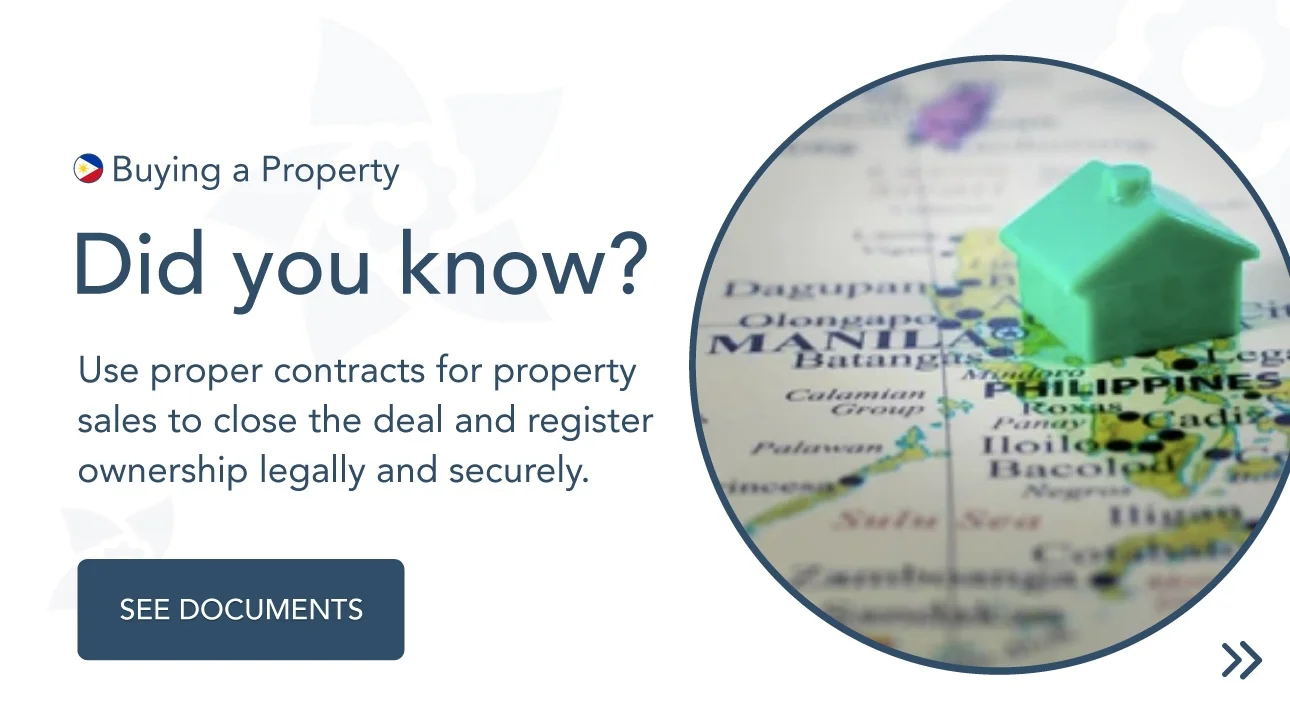Home › Buy a property
Learn more about Buying a Property in Philippines
Buying property in the Philippines is an excellent alternative, particularly given the industry is thriving and yields excellent returns. Furthermore, the country’s steady economy and ongoing growth make real estate investments a fantastic method to grow your money. Nonetheless, dangers exist, as with any investment. When deciding on the ideal property to invest in, it’s vital that you know what you’re doing and consider a variety of factors. Themis Partner provides you with all the legal documents you need. Download a land or real estate purchase agreement, or building documents as Construction Contract, Architect Contract, or Interior Design Contract for your property in Philippines.
Table of contents
-
Who can buy property in Philippines?
-
What conditions for foreigners to buy a property?
-
Why writting a contract when buying a property?
-
How to obtain a land title deed in Philippines?
-
What is the procedure to transfer a property?
-
What is the purpose of the earnest money in Philippines?
-
How is property tax calculated in Philippines?
Who can buy property in Philippines?
In general, only Filipino nationals and businesses or partnerships with at least 60% Filipino ownership are permitted to own or buy land in the Philippines. Foreigners or non-Philippine nationals, on the other hand, may buy condominiums, buildings, and enter into long-term land leases.
What conditions for foreigners to buy a property?
When it comes to purchasing property in the Philippines, foreigners face several limitations. It is feasible to purchase a condo or flat as long as the block is at least 60% locally owned, but owning land is more difficult. This essentially implies that foreigners can own a building but not the land on which it is built.
Purchasing a home in the Philippines might be very different than purchasing a home in Europe or North America.
Foreign purchasers face limitations, and the market is unregulated. It is critical that you get experienced local assistance to confirm that the property you are purchasing is being sold lawfully.
Here are the actions you’ll need to do once you’ve selected someone to assist you :
Step 1: Select the property you want to buy
Step 2: Look into alternate mortgage financing options. You can check with local banks.
Step 3: Agree on a sales price with the seller and, with the assistance of a lawyer, draft and notarize the Deed of Absolute Sale (DOAS).
Step 4: Obtain the Land Tax Declaration from the Bureau of Internal Revenue (BIR) and deliver it to the appropriate Assessor’s office.
Step 5: Pay the city treasury for the real estate tax.
Step 6: The Assessor’s office will evaluate the property’s worth.
Step 7: Pay the applicable transfer taxes. This must be sent to the Assessor’s office.
Step 8: The seller is responsible for paying the Capital Gains Tax and the Documentary Stamp Tax (to the BIR).
Step 9: On the Registry of Deeds, the previous property title — in the name of the seller — is replaced with the new one (RD).
Step 10: You will receive a copy of the new deed and will need to seek tax declaration documentation from the Assessor’s office.
Why writting a contract when buying a property?
An agreement is a legal contract between the seller and the buyer for the sale of property that governs each party’s mutual promises. It is an official document that certifies the sale and acquisition of the property. A sale agreement is a legal document that contains a written promise to transfer property in exchange for a fee. It documents the terms of such transfer and payment, as well as the penalty for failure to transfer or pay the dwelling.
🔗 If you wish to invest in real estate in the Philippines, we invite you to download our Real Estate Purchase Agreement written by Philippine lawyers and usable for any type of property.
How to obtain a land title deed in Philippines?
If you intend to acquire land in the Philippines, make sure you follow these measures to avoid any land ownership issues.
1. Contact the property owner or developer
Make sure to investigate or verify the owner of the land you’re buying to prevent being in a position where many parties claim ownership of the land you acquired. How? You can obtain the owner’s name and title number by requesting a photocopy of the title from the salesperson. These facts will be required in order to obtain a Certified True Copy of the title from the Registry of Deeds. The property’s Registry of Deeds is in the city or municipality where it is located.
You can verify the prominent details of the lot being sold, such as the name of the landowner and the size of the lot, once you have the CTC of the title.
2. Inspect the possible problems you may experience
Now that you have the CTC of the title, double-check to see if the description on the title corresponds to the land being sold. Aside from the title, you may also verify the description with the assistance of a surveyor, who can inspect and verify the lot’s technical description.
Another item to look for is the tax declaration for the property. You can inquire about its status at the Assessor’s Office of the municipality in where the property is located.
If the payment is not updated, the property owner/dealer must settle it or sign a notarized agreement to do so.
Finally, it is critical to confirm the identification of the person dealing for the property. Check that you are dealing with an authorized salesman or broker. With the rise of fraud in the real estate market, it is critical to investigate the agent’s or dealer’s past. You may do so by contacting the developer and asking if the agent is still with them. If you are not affiliated with a developer, you must determine whether he or she owns the land. You must ensure that all of his family members agree to sell the property via an SPA or Special Power of Attorney from the lot’s owner or owners. It is critical to confirm the identification of the one ed.
3. Secure notarized and signed sale deed (DS)
You can now proceed with the purchase of the property after you have confirmed that the title is clear. This stage requires you to get a notarized and signed deed of sale. This paperwork serves as confirmation that you own the property and contains all pertinent information about the buyer.
What is the procedure to transfer a property?
To begin the title transfer, you must furnish and submit the paperwork required by the Bureau of Internal Revenue (BIR) Revenue District Office (RDO) where your property is situated.
The following documents are required:
| ➤ The notarized Deed of Absolute Sale in its original form and two photocopies (DAS) |
| ➤ Photocopies of all deed of sale signatures |
| ➤ Notary Public's official receipt for notarizing the deed of sale |
| ➤ A duplicate copy of the Transfer Certificate Title and two copies of the Owner's duplicate copy |
| ➤ A Certified True Copy and two photocopies of the most recent land Tax Declaration for land and improvement of real property or Sworn Declaration of No Improvement for lots with no improvement by the seller or Certificate of No Improvement issued by the Assessor's Office of the municipality |
| ➤ Clearance from the Homeowners Association on taxes |
| ➤ Birth certificates, marriage certificates, and CENOMAR are examples of certificates |
| ➤ Both the Seller's and Buyer's Tax Identification Numbers |
| ➤ Certificate of No Improvement is only valid for lots |
| ➤ If the individual conducting the transfer is neither the owner or buyer of the property, a Special Power of Attorney is required. If the Special Power of Attorney is executed overseas, the Philippine Consulate must certify it |
| ➤ If the zonal value cannot be calculated from the available documents, use a location plan or a nearby map |





